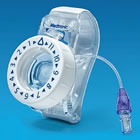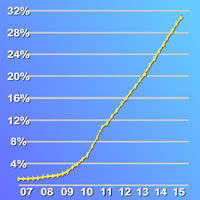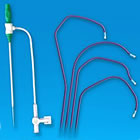|
Medtronic Goes Radial
First Major Stent Manufacturer in U.S. to Offer Full Portfolio of Catheters, Introducers, and a Hemostasis Device Designed for the Transradial Approach
|
 |

Medtronic's TRAcelet™ compression device for transradial hemostasis |
February 13, 2017 -- This morning Medtronic plc (NYSE: MDT) announced that it is now offering a full portfolio of transradial-specific tools: a line of catheters, a TRA access kit with introducer sheath, and its TRAcelet™ compression device for simplifying patent hemostasis post-procedure.
Although the company previously has marketed a select number of items designed
for the transradial approach (TRA), today's announcement marks the first full-transradial offering by a major stent manufacturer in the United States and has the potential to further accelerate the adoption of this approach among interventional cardiologists.
10 Years of Growth for Radial in the U.S.
When Angioplasty.Org began its Transradial Center in 2007, less than 2% of procedures in the United States were done via the wrist, well behind the rest of the interventional cardiology world, which was already performing 50-90% of angiography and PCI procedures transradially. (The first transradial interventions were done in The Netherlands by Dr. Ferdinand Kiemeneij in 1992. You can read more about its beginnings in our exclusive two-part interview with Dr. Kiemeneij.)

Growth of radial access in U.S. |
Through professional and public education efforts more cardiologists have become familiar and proficient with TRA, and more patients have discovered the benefits of immediate ambulation, less bleeding complications, and greater comfort. The current penetration of radial in the U.S. is estimated at 30-33%, according to Dr. Sunil Rao, who has been tracking these data from the American College of Cardiology's National Cardiovascular Data Registry (NCDR®). And it is growing.
As for how many hospitals offer the transradial approach to their patients, Dr. Rao told Angioplasty.Org that those data are expected to be published later this year. However, Dr. Rao added, "There are still labs in NCDR where the rate of radial is 0. But that fraction is shrinking fast!"
A Change Enabled by Physicians, Patients, Industry...and the Internet
How an entire profession is managing this transition from the femoral to radial approach has been nothing less than revolutionary. Physicians have had to be re-educated about the very fundamentals of catheter-based procedures. These professional education efforts have been spear-headed by a number of cardiologists who learned the procedure, mostly abroad, in Japan, India, Canada, and European centers. There are courses in hospitals, or at major interventional meetings, such as TCT, EuroPCR, SCAI, ACC, or dedicated radial courses, such as CRFTRAC, AimRADIAL, or ThinkRadial. And these courses are sponsored in large part by industry: Medtronic, Merit Medical, Terumo and more - including smaller companies that may have radial-specific products, such as Svelte Medical's "stent-on-a-wire." Few of the radial-specific products made by these companies, however, are what one would consider "big-ticket items"; they are mostly catheters, sheaths, needle devices, compression bands, etc.
Angioplasty.Org's Transradial Center Celebrates Its First Decade
As more and more U.S. physicians began offering the wrist alternative, word also spread among patients. We, at Angioplasty.Org, began evangelizing for this approach in 2007, when we created our "Radial Access Center for Transradial Approach," a special section devoted to information and news about the transradial technique, for both patients and physicians. For patients we host a "Hospital Locator" that lists centers practicing radial angiography (currently almost 400 listings).
The Radial Center also features news, courses, articles, and interviews with leading practitioners of the radial technique, such as Drs. Ferdinand Kiemeneij, Jeffrey Popma, Sunil Rao, Mauricio Cohen, John Coppola, Shigeru Saito and Jennifer Tremmel. News media also began featuring stories about hospitals (usually local) that offered this new procedure (yes, even Dr. Oz!) so patients began to seek out centers, because as Dr. Howard Cohen has told us, "Patients really prefer it. 95% of people who've had it both ways would say 'I'm coming back to you, Dr. Cohen because I like this transradial a lot better than the other way!' (By way of disclosure, our Transradial Center is supported by an unrestricted educational grant from Medtronic Cardiovascular.)
Trial and Studies Provide Outcomes to Drive Change
Finally, there has been the hard work of running clinical trial, studies, and meta-analyses, comparing the femoral and radial approaches. This topic would take a major article in itself to cover, but the bottom line is that radial has been shown to reduce bleeding complications, especially in the setting of STEMI where extensive antithrombotic agents need to be used; it increases patient comfort with the patient being able to walk immediately and recover more quickly, often in a special "radial lounge"; some studies, especially those of STEMI patients, have even shown a mortality benefit. And it is cost-effective: less equipment, less complications, shorter hospital stays: in many centers, coronary angioplasty via the transradial approach has become an outpatient procedure. Think about this: what used to be open heart bypass surgery which took months of recovery, can now be done in 20 minutes, and you go home the same day!
System-Wide Change
The education effort, however, is not just about one physician using a few tools and a new approach. In the catheterization laboratory, the entire team has to be behind this change (protocols are different, table positioning has to be altered, the "drug cocktail" is unique); in the CCU/recovery area, nursing staff has to be trained to a different style of hemostasis. Heavy compression of the kind utilized in the femoral approach can cause radial artery occlusion. Unique radial-specific techniques and pressure devices need to be used to gently achieve patent hemostasis. A phrase we coined is important in remembering the distinction: "Too long, too strong, for radial, is wrong!"
A unique part of Medtronic's offering is, in fact, their Transradial Arc CurriculumSM which approaches this change-over hospital-wide: physicians, nursing staff, and administrators are included.
More specifics on Medtronic's effort can be read in this morning's press release:

Medtronic Expands Coronary Portfolio to Include New DxTerity™ Diagnostic Catheters and Suite of Tools for the Transradial Approach
Full Line of Innovative Transradial Products and Comprehensive Training Programs Reinforce Medtronic's Commitment to Optimizing the Treatment of Heart Disease

Medtronic's new transradial catheters and access kit |
February 13, 2017 -- Dublin -- Medtronic plc (NYSE: MDT) today announced that its market-leading coronary portfolio will now include the DxTerity Diagnostic Angiography Catheter line and several transradial-specific products including the DxTerity TRA™, InTRAkit™ access kit and TRAcelet™ compression device, all of which received U.S. FDA (Food and Drug Administration) clearance and CE (Conformité Européenne) Mark for use in diagnostic cardiac catheterization procedures and percutaneous coronary intervention (PCI).
The DxTerity and DxTerity TRA Diagnostic Catheters are used to determine whether or not revascularization is necessary in patients with coronary artery disease; the DxTerity TRA Diagnostic Catheters are specifically designed for transradial access and allow for engagement of both coronary arteries without catheter exchange. The InTRAkit access kit enhances the transradial experience by providing several component pieces-ergonomic needles that offer excellent flashback visualization,1, 2 atraumatic mini-guidewires, as well as tapered introducer sheaths that provide kink resistance3 and enhanced lubricity4 for easy insertion. The TRAcelet compression device simplifies pressure reduction post-transradial catheterization by facilitating access site patent hemostasis (i.e., stops bleeding while maintaining radial artery patency).5

Sunil Rao, MD, FACC
Duke University
|
"The global approval of the DxTerity Diagnostic Catheters, as well as the introduction of the new Medtronic suite of transradial products represents a significant step forward for patients requiring PCI procedures," said Sunil Rao, M.D., interventional cardiologist and associate professor of medicine at Duke University, in Durham, N.C. "It's increasingly important to have a full suite of products accompanied by robust training to increase physician utilization, improve patient comfort and enable same-day discharge."
In the United States, Medtronic also launched the Transradial Arc CurriculumSM, a fully-customizable education and training solution for physicians, staff and administrators to ensure successful adoption of the transradial approach from access to patent hemostasis. The curriculum aims to provide robust clinical training and enhance patient care pathways through a hospital-specific approach to help institutions optimize the delivery of transradial care.
"Our new line of comprehensive transradial products and programs that support PCI from start to finish were developed to meet the evolving clinical and health economic needs of physicians, administrators and cath lab teams around the globe," said Jason Weidman, vice president and general manager of the Coronary and Renal Denervation business, which is part of the Cardiac and Vascular Group at Medtronic. "Our intent with these recent innovations in our premium product portfolio is to help accelerate adoption of the transradial approach so that more patients and hospitals may experience the advantages transradial access can bring."
A meta-analysis of randomized studies that studied the transradial approach generally have found that procedures via the transradial approach (through a patient's wrist) have been associated with cost savings,6, 7, 8 reduced mortality and improved safety with reductions in major bleeding and vascular complications.9
The DxTerity and DxTerity TRA Diagnostic Catheters, TRAcelet compression device and the InTRAkit Access Kit are commercially available in the U.S., as well as throughout Europe. The Transradial Arc Curriculum is only available in the U.S.
In collaboration with leading clinicians, researchers and scientists worldwide, Medtronic offers the broadest range of innovative medical technology for the interventional and surgical treatment of cardiovascular disease and cardiac arrhythmias. The company strives to offer products and services that deliver clinical and economic value to healthcare consumers and providers around the world.
About Medtronic
Medtronic plc (www.medtronic.com), headquartered in Dublin, Ireland, is among the world's largest medical technology, services and solutions companies - alleviating pain, restoring health and extending life for millions of people around the world. Medtronic employs more than 88,000 people worldwide, serving physicians, hospitals and patients in more than 160 countries. The company is focused on collaborating with stakeholders around the world to take healthcare Further, Together.
Any forward-looking statements are subject to risks and uncertainties such as those described in Medtronic's periodic reports on file with the Securities and Exchange Commission. Actual results may differ materially from anticipated results.
- Preclinical studies on file at Medtronic. Preclinical data may not be indicative of clinical results.
- Based on physician feedback during preclinical study and compared to participants' current clinical experience; data on file at Medtronic.
- Bench test data on file at Medtronic. Bench test data may not be indicative of clinical results.
- Bench test data on file at Medtronic. Bench test data may not be indicative of clinical results.
- Data on file at Medtronic
- Amin AP et al. J Am Coll Cardiol. 2012;59;E338.
- Jolly SS et al. The Lancet. 2011;377(9775):1409-1420.
- Ewen et al. J Interv Cardiol. 2009;22(3):266-273.
- Giuseppe F et al. J Coll Cardiol Intv 2016;9:1419-34
Reported by Burt Cohen, February 13, 2017
|




